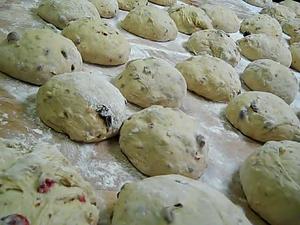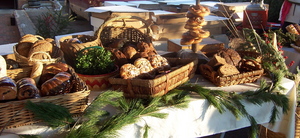A visit with Mill Pond Bread

Mill Pond Bread's stollen dough formed into loaves.
Corinna Borden | Contributor
Talking to John, I felt like I was looking down a telescope into the past. It was awe-inspiring hearing about a group of avant-garde food luminaries that decided to work with organic food in the 1970s. Thankfully, their hard work then is still part of our food landscape today, 30 plus years later.
John Savanna worked at Indian Summer (a restaurant included in the 1973 Environmental Action Bulletin published by Rodale Press, of longtime organic fame) that was owned by Ken King (of Frog Holler Organic Farm) and Rick Peshkin (of the Produce Station). John worked with Ken at Frog Holler and soon realized that he would like to try making bread. “It was on a whim, I didn’t know what I was doing.” That may have been true 30 years ago, it is not true anymore.
The bakery facility has been in different locations over the years and at the moment is in Chelsea. He uses unbleached, unbromated, and as much organic flour as he can. They bake on Tuesdays, Thursdays, and Fridays to supply the demand for their goodies at the Ann Arbor Farmers Market, Morgan & York, Foods for Living, and Plum Market (over the years Mill Pond Bakery has been sold at many of our local stores).
We talked about why he likes stone milled flour. “With stone ground, you are getting the germ and the bran all together, now I can add more water because I am getting a better crumb structure.” (Crumb structure is what bakers call everything that is not the crust).
Here is where I take an aside to discuss gluten and protein. The amount of gluten that can be formed has to do with the level of protein. Higher protein flours (14% protein) are good for stronger gluten (think of the big holes in bread), lower protein flours (9% protein) are good for weaker gluten (think of the crumbly texture of cake made from cake flour, ie lower protein flour).
John Savanna uses different levels of protein in his flour because the strength of the gluten affects how long he can ferment his dough. (Fermenting is another term for proofing or allowing the dough to rise). He feels the longer you let bread ferment the more depth of flavor develops.
He agrees with me about the need to use unbromated flour. “The bromates [are] so unhealthy ‘cause they [are] just trying to speed up the whole process. Everything that we are doing, we’re trying to go the opposite way, slow it way down. Ferment it so it is at least 20 hours, 24 hours (or longer) old. Because then it is good for your gut.”
What is good for my gut is also good for my taste buds. I found the loaves very rich and unique, the sour and sweetness working to create a depth of flavor that lasted in my mouth long after I had swallowed. The crumb was yielding and firm a pleasant consistency for chewing.
I enjoyed eating the Swedish Rye, the Schnitzbrot (a holiday spice dough filled with dried pears, dried plums, apples, raisins, cranberries walnuts, almonds, pecans, zest of orange, honey, molasses, cloves and cinnamon), and the Lithuanian Rye.
Grabbing one of their pretzels and wandering around the Farmers Market is one of the best things to do on a Saturday morning.

Mill Pond Bread's display on an early morning Market day.
Corinna Borden | Contributor
Drop me a line! Check out my website! Read my book! Post a comment and start the conversation rolling!


Comments
roadsidedinerlover
Thu, Jan 14, 2010 : 7:45 p.m.
I love Mill Pond Bread but I wish it was sold in Chelsea. Since you are located that way, is there any chance we can buy it town? I would drive to Chelsea to buy this bread. I won't drive to Ann Arbor for Zingerman bread at all. (not my cup of tea)
Oksana Posa
Thu, Jan 14, 2010 : 6:05 p.m.
Thank you for your report, Corrina. Ann Arbor is a better place on Earth because of UMS and Mill Pond Bakery. John's bread is a symphony in the mouth...